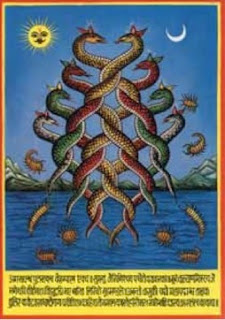Naga Panchami (The day of the Snake Gods)
 The day of the snake gods, the fifth of the brightening lunar fortnight late in July or early August is celebrated to offer worship and to show reverence to serpent gods believed to be dwelling down in Patal, the Nether world.
The day of the snake gods, the fifth of the brightening lunar fortnight late in July or early August is celebrated to offer worship and to show reverence to serpent gods believed to be dwelling down in Patal, the Nether world.
This festival is observed because of the belief that the snake gods, when assuaged, bring sufficient rains, prevent water fountains from draught, cure disease and guard treasures. Special offerings of milk, ghee is made to please the snake deities near water sprouts, pools, springs and streams. Picture of snake deities are made and pasted on front doors on the occasion.
According to Puranic scriptures, Brahma's son Kashyapa had four wives. The first wife gave birth to Devas; the second to Garudas; the third to Nāgas; and the fourth to Daityas. Nāgas were the rulers of Patal Lok.The names of the Nine Great Nāgas are: Ananta, Vāsuki, Shesha, Padmanābha, Kambala, Shankhapāla, Dhārtarāshtra, Takshaka, and Kaliya:
According to the scriptures, Lord Krishna conquered Naga Kāliya and put an end to the evil deeds on this day (Nāga Panchamī). Tradition says that Kathmandu valley used to be a vast lake. When human beings started to drain the lake to make space for settlements, Nagas became enraged. To protect themselves against the wrath of Nagas, people gave the latter certain areas as pilgrimage destinations, thus restoring harmony in nature.
According to other scriptures, a king used his Tantric powers to force Nagas to return to the land and control the rains. The Nagas complied, but in recognition of their power to control the rains, the king established the Naga Panchami festival.
In Jainism and Buddhism the snake is regarded as sacred and has divine qualities. It is believed that a Cobra snake saved the life of Buddha; another protected Jain Muni Parshwanath.
During the festival, Nepalese people traditionally place pictures of Nagas above the doors of their homes to ward off evil spirits, offer prayers to Nagas, and place food items such as milk and honey in their fields for Nagas. A few men wearing demon masks dance in the streets as a part of a ritual. Hindus in Nepal have their own legends surrounding Nagas, which lead them to celebrate Nāga Panchamī on a large scale.



Comments
Post a Comment